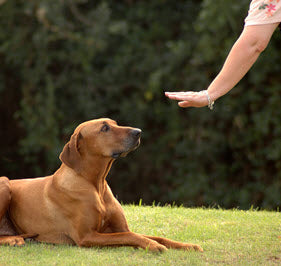If one of your New Year’s resolutions involves better behavior … for your dog … you are not alone. In fact, January has been named National Train Your Dog Month. Perhaps you’ve tried training your pooch in the past, only to end up in frustration for you and no real progress for your dog. The important thing is that you’re not giving up!

It’s important for all dogs to understand basic commands and demonstrate good behavior around others. Here are some tips that may result in more successful training this time around.
Keep it enjoyable. If you’re not in the right mood for training, don’t even start. Wait until your mind is relaxed and positive. Keep training sessions short – under 10 minutes – to keep your dog’s attention. If he isn’t responding to your commands, return to a simpler command you know he will get right and move to more complex commands later. End the session on a positive note.
Start with basic commands. Basic obedience commands include COME, HEEL, SIT, DOWN and STAY. In addition to the verbal commands, learn the hand signals that coincide with these commands. Especially in a loud, busy environment, your dog may not always hear you, but they can see your hand signals. As you move to more complex commands, these basics can be introduced when their attention seems to drift.
Do not use punishment. There should be no hitting, yelling or chain jerking when your dog isn’t following your command. Instead, keep the response positive, only rewarding him for a job well done. It’s in every dog’s nature to please his owner in return for attention, food or playtime. He will learn fast that unacceptable behavior will not produce a reward.
Time the reward. Keep your dog’s motivation at the highest level by timing it with his greatest time of need. For example, if your dog responds to food, start the training session before his meal, not after. Or if you are working on more complex commands, take your dog for a walk first to burn off his excess energy and increase his attention span. Also, make sure you deliver the reward within ½ second of the good behavior so that your dog makes the connection between his good behavior and the reward.
Pick the reward. Select the reward that is most powerful for your dog. If it is food that motivates your dog, pick something really tasty and easy to swallow – like cheese or a liver bite – no bigger than your fingernail. If he thrives on praise, give it enthusiastically and in high singsong tones.
Use short commands. Use short words for the command and say them only once. Your dog will remember a command for about two minutes before the notion is lost. Also, words that end in a hard consonant such as C, T, X or K are better than ones that end in a vowel. When giving the COME command, however, you may need to say your dog’s name first, then COME, then good boy so he knows he is not in trouble.
Get his attention. Train your dog to focus on your face and give you his full attention. Rewarding eye-to-eye connection with you will give your dog the message that training time is not play time, and that you are the one in command. Get him to look you straight in the eyes. Then take a food treat and slowly stretch your arm away from your body. If his gaze goes to the treat, start over. He will soon learn keeping his focus on you will result in his getting the treat.
Lengthen the response. Once your dog has mastered the SIT-STAY command, lengthen the time until he can stay in that position for one minute while you are at least 5 feet away. Using a key phrase like EASY or STEADY during the exercise will reassure your dog he is still engaged in that command. Using a release phrase like FREE or RELEASE will tell your dog that period is up.
Intermittent rewards. Once your dog has mastered his behavior on the continual reward schedule, start to reward two out of every three times, and so on, so that your dog gets out of the habit of working only if there is a reward involved. But be sure to give your dog praise after every successfully completed command, whether there is a reward coming or not.
Change the environment. When your dog has mastered following commands in a quiet environment, start introducing places that have more distractions. Start outside in the yard, move to a park or while on a walk, and eventually work up to a dog park or a busy, noisy street. It’s important to be able to keep his attention and maintain control in the busiest of situations.
We hope these tips will result in a better training experience for you and your dog in 2017.
This blog is brought to you by Under the Weather®, provider of bland diet products for dogs. These bland diet products offer a quick and convenient solution when dogs experience digestive issues such as vomiting or diarrhea. Ready to go in minutes – just add boiling water to rehydrate.
Our bland diet recipes are made with 100% human-grade meats – no meat by-products, antibiotic free and no hormones added! They are gluten free and have no chemicals or dyes. Sourced and manufactured in the U.S.A.
View Our Products
Visit Our Blog Library




